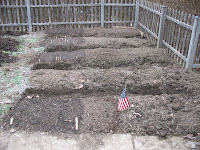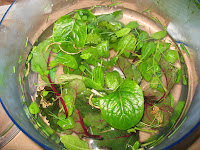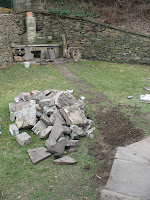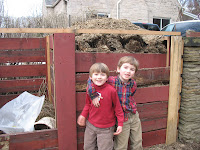I have a full load of manure, a compost pile that needs firing, and soil that needs to be worked. It is 50 degrees with a light rain falling. I got to work around 6:30 am. The rain only lasted a couple of minutes. I started in the compost pile. I had previously emptied all the finished compost out of the left pile and it was ready for more. I did my best to build alternating layers carbon (sticks and wood chips) with nitrogen (mushroom manure). Much of the pile was still frozen, so about 8 am. I took a break and moved on to other things.
The other thing I moved on to was the sun garden. We call this area the sun garden because it gets the most sun (obviously). This is year #2 for this plot. Last year we didn't really get it rolling until mid summer for tomatoes and peppers. This year the soil is much, much better, but still not wonderful. It still has a lot of rocks and some clay. The sun garden is approx

16 X 16. My garden plan has me breaking it into 10 - 30 in X 7 foot rows. Today I prepped and began planting 5 of those rows (the east 5). Based on the advice of the author of
The Four Season Harvest, I didn't turn the soil this year. Instead I just spread some lime and some compost on top, and raked it in the top couple inches of soil. Then I dug out the paths and spread that soil on top of the planting rows. When I was done I had what looked like raised beds, but really could be described as sunken paths. In those paths, I spread green manure (mix of alfalfa and clover). I used rocks for the paths last year and wasn't really pleased with the results. Here is what I planted in the sun garden today...
- Row #1 - about 75 peas (snow peas - goliath - shumway). I inoculated
 them and planted them very, very tight. Took up about 1/3 of the row (left part - this part gets most sun). I set off the peas with a light row of radishes for marking.
them and planted them very, very tight. Took up about 1/3 of the row (left part - this part gets most sun). I set off the peas with a light row of radishes for marking. - Row #2 - This is the cabbage family row. I planted 3 cabbage seeds and 3 broccoli seeds. I put them on 12 inch centers, so had lots of space in between. In between I put little lines of green onions, and spinach, which will be long gone when the cabbage and broccoli start crowding the row.
- Row #3 - This is the root crop row. I did two little plots of carrots ("early bird garden", nantes type - shumway freebies) and beets (early wonder - shumway). I did a really nice job with these plots. I used my deep tined fork to pull out about the top ten inches of soil in a little 20 x 10 inch mini plot. Then I loosened the remaining soil with the fork. Using my new compost screener (built by me, Quinn and Carter), I filled the plots with screened compost, soil and mushroom manure. This planting meduim was light and fine. I can just picture the carr
 ots and beets shooting down through it with ease, making wonderful, long root crops.
ots and beets shooting down through it with ease, making wonderful, long root crops.
- Row #4 - left blank - I have bush beens planned for this row.
- Row #5 - This is the onion row. I planted about 30 onion seedlings
 . Quinn helped.
. Quinn helped.
In the past I would have fully planted these rows. This year, I am really trying to be patient and build a much longer harvest season, and better variety through succession planting. I intend to do smaller plantings every couple of weeks, rather than one huge planting.
After finishing up the planting, I headed back to the compost pile and finished sorting it. I was able to remove 4 wheelbarrows of compost and dump it in the left half of the sun garden, to be worked in the coming weeks. This compost was by no means finished, but I am not a compost snob. I don't mind a few eggshells and chunky sticks in my compost. I have also learned from experience that some of the best and fastest way to break down partially finished compost is to let the soil organisms in the garden take their crack at it. When I was done, the "green bin" was about 3/4 full and the "black gold" bin had about 16 inches of the good stuff. I feel really good about this compost activity today. I fully expect the layering and aerating I did today combined with the rising temps to get both piles fired back up and cooking. I would be shocked if I don't feel some heat coming off those piles tomorrow.
Sarah did some work outside today as well. She turned a small 4x4 section of grass and prepared it for flowers. Over the last two years we have removed several plots of grass in the same manner and are slowing building perennial flower gardens.
No signs of any seeds sprouting anywhere yet. I watered all seeds and seedlings with compost tea. We came in at about 5:30 - after spending over 10 hours outside on a beautiful, warm pre-spring day.












































